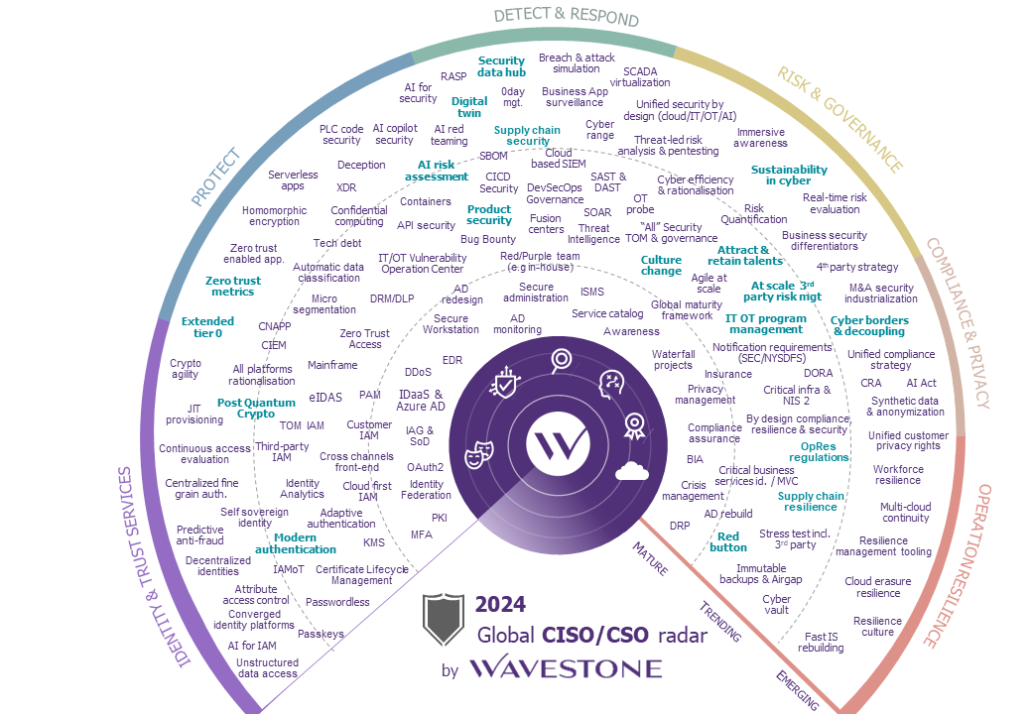The landscape in 2024
In 2023, we released an insight paper outlining what we anticipated to be the key priorities for CIOs going in to the new year; predictions heavily influenced by a number of global factors and volatile market conditions. We predicted that supply chain would be disrupted, the war for talent would continue and that cybersecurity and cloud would be high up on the CIO’s agenda.
As we reach 2024, the socioeconomic and political landscape continues to be a persistent pressure, and organisations are still feeling the challenges of both these factors. CIOs must be heavily resilient in the face of these circumstances to ensure long-term success and minimal operational disruption.
We predict that 2024 will be dominated by one topic – Generative AI. This is of course to be expected, with GenAI already having some form of impact across almost every part of the business. At this stage businesses are experimenting with the technology and exploring use cases across different parts of the business. However, the next 12 months will likely be one of continued growth and increased expectation from the technology, where businesses consider a long-term AI strategy to not only mitigate risk but also to reap its full benefits.
It’s not all AI though. The persistent economic pressures mean extra scrutiny continues to be placed on budgets and potential cost savings. Multi-year strategic targets for cloud adoption and sustainable operations means they are still primary topics for CIOs to address; targets further amplified by increasing regulations and new tooling. Furthermore, the fast-paced environment of cybersecurity is a pressing concern that all CIOs must consider, as the advent of emerging technologies provides even more entry points for malicious attacks.
This article will outline what we believe to be the top 5 trends that will be observed in the year to come, and how these can be addressed:
Intelligent Automation & AI Ops
Trend 1: Generative AI Takes Centre Stage
It is of little surprise that GenAI and Intelligent Automation (IA) will be the primary focus of a large proportion of businesses going in to 2024, especially with the mark they already made in 2023. Considering the increasing prioritisation on both the need to innovate effectively and efficiently, these technologies provide a perfect storm to automate or augment workloads and significantly improving productivity.
We anticipate GenAI will be a trademark tool to improve efficiency for the coming years. For example, Microsoft’s GenAI Assistant ‘CoPilot’ will become a permanent residence to the keyboards of Windows PCs, setting an industry precedent for the longevity of AI tools. Working in conjunction with these tools will set organisations in good stead for technology advancements to come as well as understanding their impact. Head over to our insight to learn how to successfully maximise the uses of CoPilot.
However, intelligent automation and AI alone are not expected to be an all-encompassing solution. An element of oversight will be required for these implementations to be successful. For example, Gartner predict over 50% of software engineering leaders will explicitly require oversight of GenAI next year, indicating the importance of adaptability and adoption to holistically leverage productivity gains from AI. In fact, to reap the full benefits of your GenAI solution and its many complexities, there are several considerations that need to be made.
For adoption of intelligent automation and AI to be successful, an important consideration is data governance, both from a data protection perspective and ensuring the accuracy of output from automated tools. We recommend our clients conduct a thorough review of data governance frameworks as well as assessments of general AI estate maturity in the organisation.
For further insights into the current and future state of AI, check out our Road to AI series.

Callum Lyons
Senior Consultant
Intelligent automation has been a common topic with CIOs for the past decade, and we are seeing increasingly sophisticated systems being able to handle business processes and decision making. Successful clients tend to enable more of these opportunities through adopting a mindset of seeking out continuous improvement and innovation, making it a norm within their culture.
AI Risk
Trend 2: Increased Risk With AI Needs To Be Addressed
With the advent of AI, an increasing focus in the past year has been on the risks of using AI within organisations to achieve increased efficiencies. Especially with the introduction of the AI Risk Management Framework by the NIST in the US and the EU AI Act, it is likely there will continue to be more scrutiny around AI Trust, Risk and Security Management (AI TRiSM) in 2024.
Integrating foundation models such as Large Language Models (LLMs) in organisations can lead to new risks in the following areas:.
- Content anomalies, such as malicious use or copyright infringement
- Data protection, particularly due to lack of governance
- AI application security against hacker attacks to database or model.
Many organisations who are piloting and researching GenAI may not have AI TRiSM controls or policies in place, often relying on external solutions for AI models hosted by other vendors. This increases the difficulty of controlling risks as it is harder to perform assessments in externally hosted environments and data processors.
Throughout 2024, organisations taking advantage of AI operating models should establish a task force and decide the obligations their risk framework should achieve to understand where there are overlaps with current initiatives. Our AI Risk experts recommend reviewing existing risk frameworks, assessing data strategies, and setting up a robust AI governance model with leadership training.

Mathew Wells
Associate Partner
As AI evolves and it’s commercial adoption expands across industries, companies will have to navigate and manage the increasingly complex risk management and governance challenges that Gen-AI models present.
ICP / CLOUD
Trend 3: Time to Finalise Cloud Migration
Last year, we predicted that cloud technologies would continue to be a dominant topic in the CIOs agenda, from both an adoption and a FinOps perspective. This rung true, with Gartner observing a 17.8% increase in end-user spend on public cloud services.
Owing to the multi-year nature of cloud adoption roadmaps, this trend is expected to continue into 2024. Cloud computing is becoming ever more necessary for businesses, a fact increasingly pertinent as emerging technologies such as spatial computing and AI start to take centre stage. Organisations need to prioritise appropriate cloud maturity and finalise adoption.
2024 could see a new player in the cloud adoption world in the form of Industry Cloud Platforms (ICPs). ICPs, a combination of SaaS, IaaS, and PaaS services into one all-encompassing package, offers the potential to streamline migration to the cloud, whilst offering a fully connected cloud strategy and potential long-term savings. Although in the early stages of its lifecycle, this year will prove whether ICPs can break through their initial hype cycle and evolve into a new generation of agile cloud management services.
Whilst cloud computing is essential to businesses today, it is vital that costs are optimised and controlled to maximise operational benefit. For more information on how to best control expenditure in cloud, our recent blog details optimisation levels for FinOps operating models.

Keith Thomas
Associate Partner
It is hugely important that individual organisations have a clear cloud strategy to get the best value from cloud as part of their overall technology strategy, including, as a minimum, having a clear plan for cloud migration and delivering on this. Driving this allows organisations to focus on areas which offer improved value or capability such as ICPs, AI and other advanced analytics.
Sustainability
Trend 4: Sustainable IT Remains a Primary Consideration
With the expected development of a UK Sustainability Disclosure Standard (UK SDS) in July 2024, CIOs can expect increased scrutinization to consider their environmental impacts from a regulatory, resource, and reputation standpoint. In fact by 2027, CIOs could even expect their personal compensation linked to their sustainable technology impact.
Considering the overarching objective of cost optimisation, prioritising sustainability can also help to reduce cost savings in the long run. In the next 3 years, Gartner predict 75% of organisations will implement data centre sustainability programs which can lead to up to 60% in cost savings. Maintaining high sustainability standards also plays a key role in managing the carbon footprint of your IT estate. Processes such as increasing product lifespans by 1-3 years can reduce waste as well as delaying expenses.
Alongside Infrastructure and Operations, IT Leaders are also now faced with the task of selecting appropriate and effective suppliers who can maintain their ‘green’ agenda and limit their Scope 3 emissions. Sustainability credentials are expected to become a core criterion for IT products and services and a prerequisite for RFP processes, shifting market culture towards increased competitiveness for sustainable providers.
For further reading on this topic, our insight shares the ongoing transformation of Wavestone’s clients to tackle environmental challenges.

Marta Koscielak
Manager
Embracing sustainability should be a strategic imperative for organisations – implementing more sustainable practices, processes and tools will enable them to stay competitive, fulfil regulatory requirements, attract and retain talent and in some cases also optimise costs.
Cybersecurity
Trend 5: Cybersecurity’s double-edged sword: AI
Cybersecurity was a pressing topic in 2023, and this looks to continue not just into 2024, but for years to come as reliance on IT systems prevails. Business targeted cyber-attacks are increasingly prevalent, and investment in threat detection, risk prediction, and operational resilience remains a high priority for CIOs and CISOs.
AI seemingly impacts every aspect of business, and this is especially true when it comes to cyber-attacks. AI offers the potential to level up campaigns, aiding in the creation of fast acting and widespread attacks that are highly efficient on a large scale, whilst covering a range of shortfalls in current attacks to make them harder to detect for end-users.
In the UK Government’s discussion paper on Frontier AI, released in a few months ago, it was highlighted that AI-augmented cyber-attacks are already being observed, yet AI also provides an increased line of defence against potential threats to possibly nullify their increased potency. Regardless, as actors on both side of the battle aim to utilise AI to their advantage, there is little doubt that this will be a dominant trend in the cybersecurity space in 2024.
For a detailed look into the top security priorities for the next year, such as operational resilience, cloud security, and zero trust, check out our 2024 CISO radar.
Final Thoughts
- Generative AI will be a major priority for most businesses as they look to capitalise on the promised efficiency and productivity benefits, however extra consideration should be taken to ensure the solution is right for the use case.
- AI Risk management is a crucial step in the adoption of generative AI, with risks on content infringements, data protection, and application security pressing topics for CIOs to address in their risk framework.
- Cloud technology adoption should be finalised in 2024 whilst ensuring costs are optimised to maximise future benefits. ICPs offer a new way to achieve this goal.
- Sustainability will continue to be a major topic, backed by potential new regulations that place increased scrutiny on green practices. This should be seen as an opportunity for long-term cost savings.
- Cybersecurity practices will need to be adapted to include the recent prevalence of AI, both in defence and monitoring, but also to offset the rise in AI-augmented attacks.





